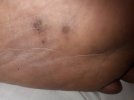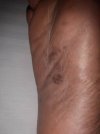Navigation
More options
You are using an out of date browser. It may not display this or other websites correctly.
You should upgrade or use an alternative browser.
You should upgrade or use an alternative browser.
Naomba kuuliza huu ni nini?
- Thread starter MIGUGO
- Start date
STRUGGLE MAN
JF-Expert Member
- May 31, 2018
- 8,638
- 16,566
Viatu unavyovaa badilisha , jaribu kuvaa socks pia
njoo kwetu
JF-Expert Member
- Jan 11, 2016
- 801
- 1,786
Ila wewe ni m****e...







hiyo ni hatua ya awali ya miguu yako kuwa kama ya chui. Hongera sana
Herbalist Dr MziziMkavu
JF-Expert Member
- Feb 3, 2009
- 42,299
- 33,082
Huu ni ugonjwa wa ngozi kwa jina unaitwa Wart aka Masundo sundo aka Visunzi miguuni. Unasababishwa na Virus wanaoitwa kwa jina hili ( Human PapillomaVirus) (HPV)Ni Ugonjwa unaosababishwa na kuambukizwa na maradhi ya zinaa. Unatibika Hospitali na pia dawa za Asili.Nimepata hii kitu haina maumivu wala muwasho je hii ni nini na tiba yake ikoje?View attachment 1642714View attachment 1642715
Wart
Warts are typically small, rough, hard growths that are similar in color to the rest of the skin.[1][3] They typically do not result in other symptoms, except when on the bottom of the feet, where they may be painful.[3] While they usually occur on the hands and feet, they can also affect other locations.[1] One or many warts may appear.[3] They are not cancerous.[3]Warts are caused by infection with a type of human papillomavirus (HPV).[1] Factors that increase the risk include use of public showers, working with meat, eczema and a weak immune system.[1][3] The virus is believed to enter the body through skin that has been damaged slightly.[1] A number of types exist, including "common warts", plantar warts, "filiform warts", and genital warts.[3] Genital warts are often sexually transmitted.[5]
Without treatment, most types of warts resolve in months to years.[1] A number of treatments may speed resolution including salicylic acid applied to the skin and cryotherapy.[1] In those who are otherwise healthy, they do not typically result in significant problems.[1] Treatment of genital warts differs from that of other types.[3]
Warts are very common, with most people being infected at some point in their lives.[2] The estimated current rate of non-genital warts among the general population is 1–13%.[1] They are more common among young people.[1] The estimated rate of genital warts in sexually active women is 12%.[5] Warts have been described at least as far back as 400 BC by Hippocrates.[4]
Types
A range of types of wart have been identified, varying in shape and site affected, as well as the type of human papillomavirus involved.[6][7] These include:- Common wart (verruca vulgaris), a raised wart with roughened surface, most common on hands, but can grow anywhere on the body. Sometimes known as a Palmer wart or Junior wart.
- Flat wart (verruca plana), a small, smooth flattened wart, flesh-coloured, which can occur in large numbers; most common on the face, neck, hands, wrists and knees.
- Filiform or digitate wart, a thread- or finger-like wart, most common on the face, especially near the eyelids and lips.
- Genital wart (venereal wart, condyloma acuminatum, verruca acuminata), a wart that occurs on the genitalia.
- Periungual wart, a cauliflower-like cluster of warts that occurs around the nails.
- Plantar wart (verruca, verruca plantaris), a hard, sometimes painful lump, often with multiple black specks in the center; usually only found on pressure points on the soles of the feet.
- Mosaic wart, a group of tightly clustered plantar-type warts, commonly on the hands or soles of the feet.
Cause
Warts are caused by the human papilloma virus (HPV). There are about 130 known types of human papilloma viruses.[8] HPV infects the squamous epithelium, usually of the skin or genitals, but each HPV type is typically only able to infect a few specific areas on the body. Many HPV types can produce a benign growth, often called a "wart" or "papilloma", in the area they infect. Many of the more common HPV and wart types are listed below.- Common warts – HPV types 2 and 4 (most common); also types 1, 3, 26, 29, and 57 and others.
- Cancers and genital dysplasia – "high-risk" HPV types are associated with cancers, notably cervical cancer, and can also cause some vulvar, vaginal,[9] penile, anal[10] and some oropharyngeal cancers. "Low-risk" types are associated with warts or other conditions.[11][12]
- High-risk: 16, 18 (cause the most cervical cancer); also 31, 33, 35, 39, 45, 52, 58, 59, and others.
- Plantar warts (verruca) – HPV type 1 (most common); also types 2, 3, 4, 27, 28, and 58[citation needed] and others.
- Anogenital warts (condylomata acuminata or venereal warts) – HPV types 6 and 11 (most common); also types 42, 44 and others.[13]
- Low-risk: 6, 11 (most common); also 13, 44, 40, 43, 42, 54, 61, 72, 81, 89, and others.
- Verruca plana (flat warts) – HPV types 3, 10, and 28.
- Butcher's warts – HPV type 7.
- Heck's disease (focal epithelial hyperplasia) – HPV types 13 and 32.
Caleykiss
Member
- Jan 29, 2018
- 21
- 22
hiyo ni hatua ya awali ya miguu yako kuwa kama ya chui. Hongera sana



Similar Discussions
-
Nateswa na ugonjwa huu wa ajabu, msaada tafadhali
- Started by Hjalte
- Replies: 46
-
Msaada kuhusu muwasho mkali wa ngozi
- Started by Forrest Gump
- Replies: 9
-
Nina makovu yaliyobaki kwenye kichwa cha uume
- Started by Future Bill
- Replies: 26
-
-
Mkono wangu umevimba ghafla. Tatizo ni nini?
- Started by Melki the Storyteller
- Replies: 44

